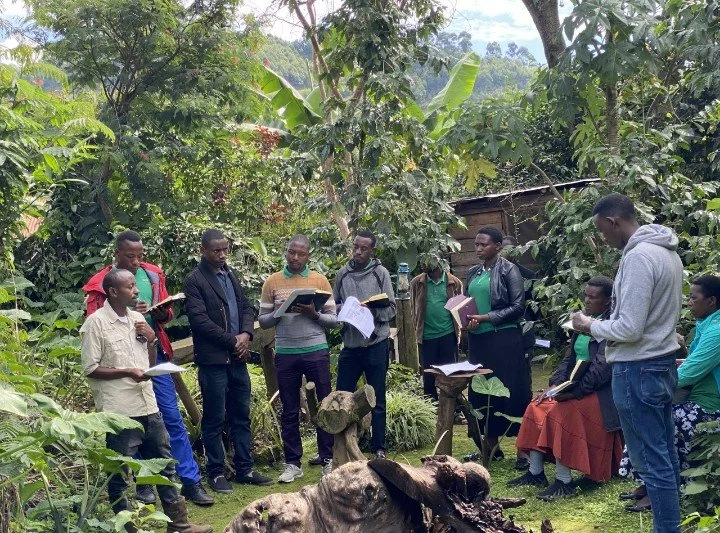Discover where the Opportunity hides, Could Food Forests be the answer to Uganda and Africa’s Declining Agricultural Practices?
The concept of Regenerative agriculture and Agroforestry in Uganda and Africa is one that is not new; in fact, the ability to intentionally integrate trees and shrubs into crop and animal farming systems to create environmental, economic and social benefits has been highly recommended by men of old.
However somewhere along the way, the Ugandan farmer (commercial and subsistence) alike, became uncertain of the working ways of organic farming and opted for chemicals in the farm ecosystem.
The use and application of agrochemicals including pesticides and fertilizers remains a big challenge for small scale farmer holder groups across the country.
Food Forest Africa Founder Gerald Nkusi says, the true deception lies in the fact that these chemicals increase plant and animal crop production and yet what they truly do is damage the soil, kill the beneficial insects and micro-organisms needed for nature’s balance in the soil and gardens, poison the men, women, children and the general environment that includes the water sources as a result of runoffs leaving them feeble and intellectually oblivious to the consequences of their actions.
More stories of hope and revival are being generated every day from hundreds to thousands of food forests creations across the country like one located in the rugged hills of Kisoro District where Nkusi Gerald has dedicated part of his time and resources to be the regional training hub for young and old farmers to embrace regenerative agricultural practices as a one in harmony with nature rather than against it. This is a lifetime skilling opportunity gained by the local communities as a one way of helping them own solutions to reversing the effects of food insecurity, poor nutrition and the degradation of their own land and country’s natural resources.
A renowned travel Ecopreneur, Regional and Global Climate Change Ambassador and an Alumni of an International Visitor Leadership (IVLP) - a US exchange program of 2017, Nkusi says food forests like the one created in Nyiragakoro, Nyakabande is one example of the sure ways of maintaining a healthy ecosystem that will provide food security, improve your natural health, generate income and spur your entrepreneurship ambitions if that’s your goal.
DIG members encouraged while at Home of Kigezi Food Forest.
A team of eight from Development in Gardening (DIG), working from Rubanda district (Uganda) visited a small food forest at Home of Kigezi where they spent hours on a study exchange on how to setup food forests for Batwa Communities living on the edge of Bwindi- Mgahinga national parks and Echuya Forest reserve.
The organization that works to support marginalized communities through teaching them regenerative agriculture to improve their nutrition and livelihoods benefitted a great deal from their learning visit to Home of Kigezi which also is a permanent center for the museum of Living Culture and Natural History.
Team Leader Gloria Mushabe says she has been farming since she was a little girl, practicing what her parents and their parents before them were doing.
"Spending time in this food forest has given me a feeling of what it must have been like to live in the Garden of Eden, the air is brisk and all the plants look so healthy. I really want something like this in my own home", Mushabe explained
The natural Forest Garden at Home of Kigezi is built on seven layers that include Canopy trees with fruits and nuts.
According to Nkusi, every food forest fruit or medicinal tree is now a cash crop, if you have a few coffee or Avocado trees among others in your back yard, you will have enough food for your home and a good surplus to sell in the market.
The third and very important stage is shrub layer which might include trees like lemon, oranges among others.
Shrubs are important because they stabilize the soil by fixing much needed nitrogen, they are good for grazing and browsing mammals and are rich in medicinal value for human beings.
Nkusi admits that even with very limited space, it is possible to introduce the fourth layer of herbaceous plants that might include mint, daylilies among others.
These are non- woody stems that offer great medicinal value to human beings, attract bees and butterflies which are vital in the pollination cycle and are also very attractive to add in your home environment.
Sostine Ainembabazi, a Farmer Field School facilitator says he has learnt to help ordinary farmers weigh the potential gains from organic regenerative practices versus using agrochemicals.
Some of the benefits of food forests regenerative creation practice includes Improved water retention with more efficient use, fewer pests invasion in our gardens, builds greater biodiversity, makes the land more resilient, Improves the soil health and farmer incomes, Reduced greenhouse gas emissions from agriculture and also enhances reduced waste and conserved CO2 emissions.
Ainembabazi says this practice only requires serious commitment at first, getting the land and compost ready and the creation but afterwards, the garden regenerates by itself and provides everything all year round with little input from a farmer.
Soil surface crops, also known as ground cover crops follow in the fifth step. These are good for maintenance of soil depth and are vital in biological and chemical characteristics of the soil in your garden.
The sixth layer of plants you need in your forest garden are known as rhizosphere, also known as root plants. They are good because they provide important nutrients for the soil.
A farmer may consider to plant carrots, sweet potatoes, yams and beets to achieve this stage.
All these farm products are good for the home and can be sold to make extra income for the household.
The seventh and final stage is the climbers and vines. These are essential for creating wildlife habitats because they provide shade and shelter for animals including birds which is very important for a healthy eco-system.
Some of the most common climbers and vines include passion fruits, cucumber, climbing nuts and flowers bougainvillea, blue morning glory and jasmine among others.
Nkusi says these flowers also offer medicinal remedies such as reducing stress and increasing a sense of well-being which is vital for human productivity and harmony.
The story of man and nature is one that dates back hundreds of thousands of years.
In the very beginning, the great tale speaks of perfect harmony and therapeutic beneficial co- existence between man, land and animals, as God intended, a terrestrial paradise on earth with no sickness, pain, fear or death.
The 21st century men and women, like you and me, might never get to see that perfect place God intended but we have a responsibility to be co- creators, bringing to life what has been dead for so long and one way to achieve this is adopting the food forest movement mentality and practice it.
Our Goal is empowering over 100,000 creators and Ambassadors in Uganda and across East Africa with an overall impact on more than 280 Million people by 2030.
Reach out to us to book your Mega Trainings, Creator Start Ups or Public Speaking Opportunities:
Email: foodforestsuganda@gmail.com | home.kigezi@gmail.com
Make Reservations for group visits to our Food Forest trails across Uganda and in East Africa, Call +256778278665 | WhatsApp +256702874427
To Order our Natural Healthy Products & Services, Get in touch with us using the contacts Above
Travelling with an impact and arranging a sustainable trip across East Africa Book Adventure Afrika (adventure-afrika.com) and you will directly offset your carbon Footprint while visiting the horn of Africa.


